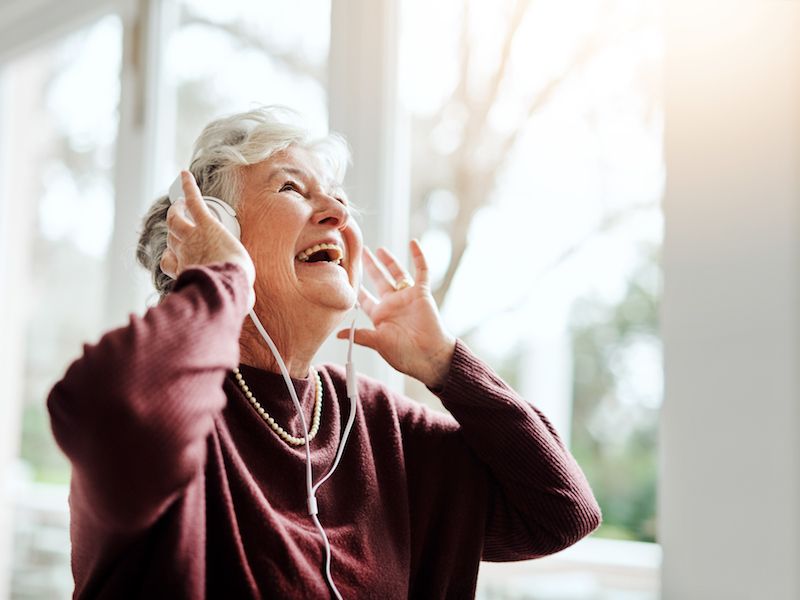
Noise-related hearing loss doesn’t only affect individuals who work in loud surroundings, such as construction workers or heavy metal roadies. It doesn’t even have to be work-related, leisure-related noise exposure can be dangerous, too. The most prevalent type? Loud noise heard through headphones, whether it’s gaming, streaming video, music, or even an audiobook with the volume cranked up.
You might be surprised to find out that a mobile device can get that loud. The typical pain threshold for human hearing is around 150 db which is well within the range of these devices. Your ears will actually start to feel pain at this volume. So what’s the plan to protect against this kind of noise-related hearing loss?
The volume level here is essential. A simple shorthand that’s widely recommended is the 60/60 rule: Listen with the volume at no more than 60% for no more than 60 minutes at a stretch (because the length of sound exposure matters, too).
Your Hearing Aids Can be Set up For Music
If you wear hearing aids, you’re most likely streaming your mobile device directly to your hearing aids, so be sure the volume is not too loud or that you’re not trying to drown out other noises with your music. In addition, ask us about how best to listen to music. If you’re a musician or someone who loves music you may have noticed that most hearing aids are developed to improve the clarity of voices…not necessarily music. We may be able to change the configuration to reduce feedback and noise while maximizing some frequency to enhance the quality of sound while listening to music.
Selecting Headphones
When shopping for headphones there are many options, especially if you use hearing aids. It might be a matter of personal preference, but there are some things you will want to consider there too.
Over-the-Ear Headphones
While the foam-covered speakers that was included with your old Walkman are largely no longer used, over-the-ear headphones have made a comeback. They have a lot of choices in color and style, are usually endorsed by celebrities, and can be surprisingly costly. And these headphones go over the whole ear stopping unwanted sound, unlike those old foam ones.
Conventional wisdom is that these are less dangerous than in-ear headphones because the source of the sound is further away from your eardrum. But the truth is they’re frequently capable of much louder volume than the smaller kind, the speakers are much larger. Noise cancellation can be a good thing as long as you’re not missing out on useful sounds such as an oncoming vehicle. That said, because they cancel out outside sound, you can normally lower the volume of what you’re listening to so it’s not loud enough to injure your ears.
Earbuds
The normal earbuds that come with devices such as iPhones are known for their inferior quality of sound, though lots of people still use them because hey, they were included with the phone. Specifically, with newer Apple devices, it’s just easier to use the earbuds which were provided with the device because it probably doesn’t have a headphone jack.
The drawback, aside from the poor sound quality, is that basic earbuds can’t block outside noises, so that it’s more likely that you will pump up the sound level. It’s generally thought that inserting earbuds so close to your eardrum is the main problem but it’s actually the volume.
Earbuds That Block Outside Sound
More comfortable than ordinary earbuds, models with a round rubber tip are the choice of many people because they help stop outside sound. The rubber molds to the shape of your ear, producing a seal that stops other sounds from entering. Not to sound like a broken record, but these types of earbuds have the same downsides as the other two (it’s all about the volume), as well as carrying the same caution as over-the-ear headphones (they can block out warning sounds). Obviously, these won’t work for you if you use hearing aids.
You might have to test out more than one pair before you find headphones that do the job. Your expectations, acoustically, will vary depending on what type of usage you usually give them. Listening to your tunes at a safe volume and coming across headphones that help you do that is essential.
How to be Sure Your Hearing is Safeguarded
Is it Safe, How Can I be Sure? There’s an app for that…If you have a smartphone, you can get the National Institute for Occupational Safety and Health’s free Sound Level Meter app. You can get other apps, but research has discovered that the reliability of these other apps is hit-and-miss (also, for unknown reasons, Android-based apps have proven to be less accurate). That motivated NIOSH to create their own app. The app enables you to measure outside sounds, but sounds coming out of your device’s speakers can also be measured, essentially, the true volume of what’s being sent to your ears. You have to put in a little effort, but putting in place these types of preventative measures can help protect your hearing.
